-
From 26 June to 2 July 2020
Session 1. AIDS, the Other Pandemic
Total session length: 45’
Gran Fury. Kissing Doesn’t Kill
USA, 1990, colour, sound, video, 2’10’’ (Four 30’ adverts). Courtesy of Electronic Arts Intermix (EAI), New York
Link to Vimeo: Kissing Doesn’t KillBarbara Hammer. Save Sex
USA, 1993, colour, sound, video, 1’. Courtesy of Electronic Arts Intermix (EAI), New York
Link to Vimeo: Save SexDavid Wojnarowicz and Phil Zwickler. Fear of Disclosure
USA, 1989, colour, original version in English with Spanish subtitles, video, 5’
Link to Vimeo : Fear of DisclosureBarbara Hammer. Vital Signs
USA, 1991, colour and b/w, original version in English with Spanish subtitles, 16mm transferred to video, 10’. Courtesy of Electronic Arts Intermix (EAI), New York
Link to Vimeo: Vital SignsTom Rubnitz. Listen to This
USA, 1992, colour, original version in English with Spanish subtitles, video, 15’
Performer: David Wojnarowicz
Link to Vimeo: Listen to ThisBarbara Hammer. Snow Job. The Media Hysteria of AIDS
USA, 1986, colour, original version in English with Spanish subtitles, video, 7’35''. Courtesy Electronic Arts Intermix (EAI), New York
Link to Vimeo: Snow Job. The Media Hysteria of AIDSPepe Espaliú. Carrying
Spain, 1993, colour, original version in Spanish, video, 2’15’’ (extract)
Link to Vimeo: CarryingThis session centres on the activism in video and in experimental film that came into existence in conjunction with the AIDS pandemic. The first part deals with the vindication of the visibility of LGTB desire confronted with the public authorities’ criminalisation of homosexuality. In Kissing Doesn’t Kill, the Gran Fury collective appropriate the aesthetics of general-interest advertising to demonstrate how the problem lies not in sexual diversity, but in government inaction and indifference in terms of disinformation. The campaign, which was never broadcast after it was initially commissioned by ABC and then later cancelled by the same network, is a classic of guerrilla communication during the spread of AIDS. In Save Sex and Fear of Disclosure, Barbara Hammer and David Wojnarowicz explore contact after testing HIV positive: Hammer shows the usual ritual of putting on and touching with gloves, and with Wojnarowicz two male go-go dancers dance and frantically touch as a voice, belonging to journalist Phil Zwickler, co-creator of the piece, speaks of the panic of physical contact with the virus. In Vital Signs, Hammer pays homage to three friends and family who passed during the pandemic — John Wilbert Hammer, her father, film-maker Curt McDowell, and Vito Russo, an LGTB activist and film historian — using the theme of macabre dance. The concerns of the other productions rest in media-created paranoia swirling around the disease. In Listen to This, Wojnarowicz plays a news presenter who delivers a tirade against the moralism and hypocrisy of American society. In Snow Job… Hammer shows a collage made with newspaper headlines that incite fear and denote the ignorance of the public perception of AIDS; “just plain wrong attitudes towards this new illness”, writes the artist. The session concludes with an extract from the historic performance Carrying by Pepe Espaliú, an HIV-positive artist who in his final months of life was carried through the air in a human chain from the Congreso de los Diputados (Spain’s Congress of Deputies) to the Museo Reina Sofía. The action was peppered with references: the involvement of the public sphere to fight the pandemic, the artist as an icon with the slogan “the personal is political” and the role of the museum as a political institution and in care, a role we wish to emphasise in this new start.
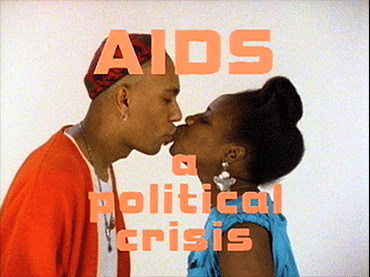
-
From 3 to 9 July 2020
Session 2. The Others Are the Disease
Jean-Daniel Pollet. L´ordre (The Order)
France, 1973, colour, original version in Greek and French, digital archive, 40’
Link to Vimeo: L´ordre (The Order)New film restored. This session features a presentation by Guillermo G. Peydró, a film essay historian and curator of the retrospective devoted to Jean-Daniel Pollet in the Punto de vista festival in 2016.
Pollet, one of the pre-eminent documentary essay makers, was commissioned by a pharmaceutical company to speak about the final days of leprosy in Europe in a film that becomes a profound meditation on the differences between the disease and supposed normality. The camera pans across deserted spaces on the abandoned Greek island of Spinalonga, officially called Kalydon, a leper colony from 1904 to 1956, the year in which an effective treatment put an end to enforced reclusion and patients started to be transferred over to hospitals in Athens. Raimondakis, a leper confined for 36 years and a clairvoyant, is the documentary’s guiding light and explains how the awareness of being ill does not start with physical symptoms, but rather with adherence to a new social order based on the discrimination between good people and bad, between the healthy and outcasts. Raimondakis describes how Spinalonga, paradoxically, used to be a hugely respected society with community support, integrated into nature, life, and the transition to death. “Where is the abnormality, in Spinalonga or on the outside?”, he asks.
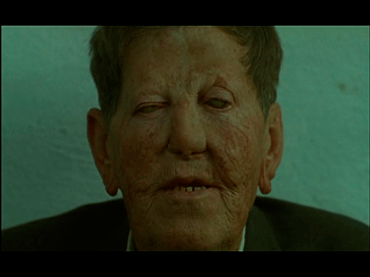
-
From 10 to 16 July 2020
Session 3. Living Under the Plague
Meredith Monk. Book of Days
USA, 1988, b/w, original version in English, digital archive, 74’
Link to Vimeo: Book of daysWith an interview with Meredith Monk conducted by John Killacky in 2006.
“Book of Days is a film about time which looks to trace a parallel between the Middle Ages — a time of war, plague, fear of the Apocalypse — and modern times of racial and religious conflicts, the AIDS epidemic and the fear of nuclear annihilation. In light of the current 2020 pandemic, the cyclical nature of this phenomenon has completely re-emerged. The film does not offer answers; it is a homage to vision and imagination, a poetic incantation of what connects us,” Meredith Monk wrote recently. With an original score by the artist, film-maker and composer, this film speaks of beauty in times of extinction.
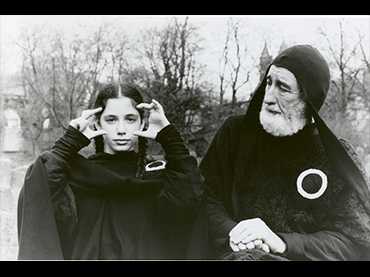
-
Monday, 20 July 2020 — 7pm / Sabatini Building, Auditorium
Session 4. Macabre Dances and Other Allegories
Second session: Wednesday, 22 July 2020 — 7pm / Sabatini Building, Auditorium
Yervant Gianikian and Angela Ricci-Lucchi. Ape-bat
Italy, 2020, colour, original version in English with Spanish subtitles, digital archive, 2’Pierre Léon, Rita Azevedo Gomes and Jean-Louis Schefer. Danses macabres, squelettes et autres fantaisies (Macabre Dances, Skeletons and Other Fantasies)
Spanish preview. France, Portugal, Switzerland, 2019, colour, original version in French with Spanish subtitles, digital archive, 110’The final session of the second part of the series Uncertain Times reopens the Auditorium after a four-month hiatus. How can an image of the pandemic be put forward that reflects death as much as the resistance to disappearance? With Ape-bat, Yervant Gianikian, a film-maker just shy of 80, composes from his confinement and solitude in Milan another macabre dance that helps him to overcome his fear, in an emblem on the origins of the coronavirus extracted from the film Fragments, made with Angela Ricci-Lucchi in 1987. Further, in Macabre Dances, Skeletons and Other Fantasies, historian Jean-Louis Schefer, with film-makers Pierre Léon and Rita Azevedo, returns to the late-medieval theme of the allegory of death, placing the stress heavily on the successive waves of the Plague in Europe. The skeletons dancing with powerful figures (popes, kings) recall the universality of death, and the necessity to revel in life.
![Pierre Léon, Rita Azevedo Gomes y Jean-Louis Schefer. Danses macabres, squelettes et autres fantaisies [Danzas macabras, esqueletos y otras fantasías]. Película, 2019 Pierre Léon, Rita Azevedo Gomes y Jean-Louis Schefer. Danses macabres, squelettes et autres fantaisies [Danzas macabras, esqueletos y otras fantasías]. Película, 2019](https://recursos.museoreinasofia.es/legacy_programs/4_6.gif)
Uncertain Times II. Representing the Pandemic
![Barbara Hammer. Vital Signs [Signos vitales]. Película, 1991. Cortesía de Electronic Arts Intermix (EAI), Nueva York](https://recursos.museoreinasofia.es/styles/large_landscape/public/Actividades/tiempos-g.gif.webp)
Held on 26 Jun, 03, 10, 17 Jul 2020
The Museo’s usual film and video programme was brought to a standstill on 12 March of this year by the COVID-19 health emergency, along with all its other on-site activities. Thus, Uncertain Times is an audiovisual series designed to be viewed on the Museo Reina Sofía website during such an atypical situation. The first part, which ran from 8 May to 4 June under the subheading Cinema During Lockdown, pivoted on the experience of confinement, while this second part explores the representation of the pandemic over three online sessions and a fourth celebrating the reopening of the Sabatini Auditorium. This will be followed, from the end of July to the end of August, by the outdoor summer cinema in the Museo’s rooftop terraces, denoting the final instalment of a series devoted to possible futures in these new times.
The COVID-19 pandemic that befell the world at the beginning of 2020 has engendered the collapse of the present continuous that defined our contemporary condition. The lack of theoretical approaches to precede and help us understand this situation has been overcompensated by a frenzied deluge of conjectural information, with this absence giving rise to a gaze towards other times and historical periods in the quest for parallels and answers. The fascination with the plague in the Middle Ages in Europe, the Americas and its deadly plagues at the onset of colonialism, or the Western world at the height of the spread of AIDS, have taken root in the collective imagination as a new historicism to find answers on how to live during an epidemic. Given that we are now seeing a progressive return to normality, in whatever form that may be, and with its restorative amnesia, this series seeks to reflect on pandemics and their representations at different times and in different audiovisual languages.
The first session bears the title AIDS, the Other Pandemic and is framed inside the special programme offered by the Museo during LGTBIQ+ Pride. It explores life and the fear of infection, and the fight against disinformation psychosis promulgated by the mass media. Salient among collectives such as Gran Fury and artists such as Pepe Espaliú are Barbara Hammer, whose work replaces vision with tactile experience in her investigations of lesbian experimental film, and David Wojnarowicz, a gay artist whose work and life were an exercise in against-the-grain survival in Reagan’s America.
In The Others Are the Disease, film-maker Jean-Daniel Pollet contemplates the new social order caused by a pandemic through one of the last outbreaks of leprosy in Europe, on an island-prison with inmates who live in harmony together and with nature. Living Under the Plague retrieves a beautiful and little-known docudrama by performer Meredith Monk, who, in a cyclical temporality, reconstructs the material and musical culture of the Middle Ages during the Plague. Finally, the last session, Macabre Dances and Other Allegories, reopens the Museo’s Auditorium with the preview in Spain of two films: a short film made by film-maker Yervant Gianikian during lockdown about a prophesy on the origins of the virus found in a colonial film from the early twentieth century, and Danzas macabras, esqueletos y otras fantasias (Macabre Dances, Skeletons and Other Fantasies), a feature-length film by Pierre Léon, Rita Azevedo Gomes and Jean-Louis Schefer.
Comisariado
Chema González
Línea-fuerza
Malestares contemporáneos
Más actividades

CLINIC 2628. A Community of Writing and Research in the Arts
February – October 2026
Clinic 2628 is a project which supports and brings together writings which stem from the intention to offer a space and sustainable time for research work in art and culture. Framed within an academic context which is increasingly less receptive to the forms in which thinking happens and is expressed, the aim is to rescue the academic from its neoliberal trappings and thus recover the alliance between precision and intuition, work and desire. A further goal is to return writing to a commons which makes this possible through the monitoring of processes and the collectivisation of ideas, stances, references and strategies.
The endeavour, rooted in a collaboration between the Museo Reina Sofía’s Studies Directorship and the Artea research group, via the i+D Experimenta project, is shaped by three annual editions conceived as spaces of experimentation, discussion and a demonstration of writings critical of what is put forward by today’s academia.
What forces, forms and processes are at play when writing about art and aesthetics? In academia, in museums and in other cultural institutions, the practice of writing is traversed by productivist logics which jeopardise rhythms of research and experimentation. The imposition of both scientism inherent in the structure of “the paper” and the quantifying of results which demand a criterion of quality and visibility sterilise and smoothen, from the outset, the coarseness that is particular to writing understood from the concrete part of language: phonic, graphic, syntactic and grammatical resistance connecting the language user to the community the language unites and activates. They also sterilise the roughness enmeshed in the same desire to write, the intuitive, clear and confusing pathways that once again connect the writer to those reading and writing, participating in a common good that is at once discovered and produced.
The progressive commercialisation of knowledge propelled by cognitive capitalism moves further away from the research and production of knowledge in artworks and artistic languages and practices. The work of curators and archive, criticism, performances and essays formerly saw a horizon of formal and emotional possibilities, of imagination that was much broader when not developed in circumstances of competition, indexing and impact. Today, would it be possible to regain, critically not nostalgically, these ways; namely, recovering by forms, and by written forms, the proximity between art thinking and its objects? How to write in another way, to another rhythm, with no more demands than those with which an artwork moves towards different ways of seeing, reading and being in the world?

The (legal) person and the legal form. Chapter II
8, 12, 15 January, 2026 – 16:00 to 19:00
As part of the Studies Constellation, the Study Directoship’s annual fellowship, art historian and theorist Sven Lütticken leads the seminar The (Legal) Person and the Legal Form: Theoretical, Artistic, and Activist Commitments to foster dialogue and deepen the hypotheses and questions driving his research project.
This project, titled Unacting Personhood, Deforming Legal Abstraction, explores the dominance of real abstractions—such as exchange value and legal form—over our processes of subjectivation, and asks how artistic practices can open up alternative ways of representing or performing the subject and their legal condition in the contemporary world.
The seminar consists of eight sessions, divided into three chapters throughout the academic year. While conceived as non-public spaces for discussion and collective work, these sessions complement, nourish, and amplify the public program of the Studies Constellation.
In this second chapter of the seminar, the inquiry into the aesthetics and politics of legal form continues with three sessions that pick up the discussions held in Chapter I but propose new lines of flight. The first session focuses on international law via the writings of the British author China Miéville, which allows us to reconsider the notion of the legal form –following Evgeny Pashukanis— and, through it, a variety of (people’s) tribunals. While the crucial concept of the legal person –as the right-holder central to the form of law— was debated in Chapter I, the second session focuses on attempts to extend personhood not (just) to corporations, but rather to nonhuman animals or ecosystems. Finally, the third session poses the question: how can groups and networks use officially recognized organizational forms (such as the foundation or the cooperative) and/or use a collective persona (without necessarily a legal “infrastructure” to match) to act and represent themselves?

Oliver Laxe. HU/هُوَ. Dance as if no one were watching you
Tuesday, 16 December 2025 – 7pm
As a preamble to the opening of the exhibition HU/هُوَ. Dance as if no one were watching you, film-maker Oliver Laxe (Paris, 1982) engages in conversation with the show’s curators, Julia Morandeira and Chema González, touching on the working processes and visual references that articulate this site-specific project for the Museo Reina Sofía. The installation unveils a new programme in Space 1, devoted from this point on to projects by artists and film-makers who conduct investigations into the moving image, sound and other mediums in their exhibition forms.
Oliver Laxe’s film-making is situated in a resilient, cross-border territory, where the material and the political live side by side. In HU/هُوَ. Dance as if no one were watching you, this drift is sculpted into a search for the transcendency that arises between dancing bodies, sacred architectures and landscapes subjected to elemental and cosmological forces. As a result, this conversation seeks to explore the relationship the piece bears to the imagery of ancient monotheisms, the resonance of Persian Sufi literature and the role of abstraction as a resistance to literal meaning, as well as looking to analyse the possibilities of the image and the role of music — made here in collaboration with musician David Letellier, who also works under the pseudonym Kangding Ray — in this project.
These inaugural conversations, part of the main working strands of the Museo’s Public Programmes Area, aim to explore in greater depth the exhibition narratives of the shows organised by the Museo from the perspective of artists, curators and specialists.
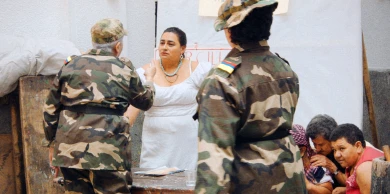
Manuel Correa. The Shape of Now
13 DIC 2025
The Shape of Now is a documentary that explores the challenges and paradoxes of memory, reparation and post-conflict justice, extending a defiant and questioning gaze towards the six-decade armed conflict in which the Colombian State, guerrillas and paramilitary groups clashed to leave millions of victims in the country. The screening is conducted by the Aesthetics of Peace and Desertion Tactics study group and includes a presentation by and discussion with the film’s director, Manuel Correa.
The film surveys the consequences of the peace agreements signed in 2016 between the Colombian State and the FARC guerrilla organisation through the optics of different victims. It was recorded shortly after this signing, a time in which doubts lingered over the country’s future, with many groups speculating in the narration. Correa harnesses the power of images, visual and bodily memory, fiction and re-staging as tools for understanding the conflict, memory and healing, as well as for the achievement of a just peace that acknowledges and remembers all victims.
The activity is framed inside the research propelled by Aesthetics of Peace and Desertion Tactics, a study group developed by the Museo’s Study Directorship and Study Centre. This annual group seeks to rethink, from a theoretical-critical and historical-artistic perspective, the complex framework of concepts and exercises which operate under the notion of pacifism. A term that calls on not only myriad practices ranging from anti-militarism and anti-war movements to activism for non-violence, but also opens topical debates around violence, justice, reparation and desertion.
Framed in this context, the screening seeks to reflect on propositions of transitional and anti-punitive justice, and on an overlapping with artistic and audiovisual practices, particularly in conflicts that have engendered serious human rights violations. In such conflicts, the role played by audiovisual productions encompasses numerous challenges and ethical, aesthetic and political debates, among them those related to the limits of representation, the issue of revictimisation and the risks involved in the artistic commitment to justice. These themes will be addressed in a discussion held after the session.
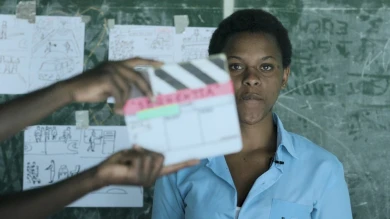
Christian Nyampeta and the École du soir
12 DIC 2025
This second instalment of Cinema Commons, a research, programming and publishing project which explores how film articulates interpretive communities, fosters collective debate and devises proposals for common space, comprises three sessions with Rwandan artist, musician and film-maker Christian Nyampeta and Ècole du soir. The programme’s first session screens video works made by Nyampeta, while the second sets forth a dialogue on the creative processes of Ècole du soir. The third brings proceedings to a close with the screening of a film selected by the artist: Ousmane Sembène’s Guelwaar (1992).
The work of Christian Nyampeta encompasses pedagogies and community forms of knowledge production and transmission. His Ècole du soir (Evening School) is an art project conceived as a mobile space of collective learning and is named in homage to Ousmane Sembène (1923–2007), a pioneer of African cinema who defined his films as “evening classes” for the people, a medium of education and emancipation through culture.
The New York-based artist from Rwanda uses art and museums to create spaces of encounter and common learning that predate colonial education models. Via popular culture frames of reference like comics, music and film, Nyampeta develops dynamics and spaces from which to build experiences which redress the wounds of diaspora and its consequences; further, his work recovers, makes visible and heals — through a pedagogical and artistic process — the social divides of the African people. With Ècole du soir he also works on creations without authorship and uses the counter-ethnographic legacy of novelist and film-maker Ousmane Sembène as a tool to deconstruct the Western view of Africa.




![Miguel Brieva, ilustración de la novela infantil Manuela y los Cakirukos (Reservoir Books, 2022) [izquierda] y Cibeles no conduzcas, 2023 [derecha]. Cortesía del artista](https://recursos.museoreinasofia.es/styles/small_landscape/public/Actividades/ecologias_del_deseo_utopico.jpg.webp)
![Ángel Alonso, Charbon [Carbón], 1964. Museo Reina Sofía](https://recursos.museoreinasofia.es/styles/small_landscape/public/Actividades/perspectivas_ecoambientales.jpg.webp)